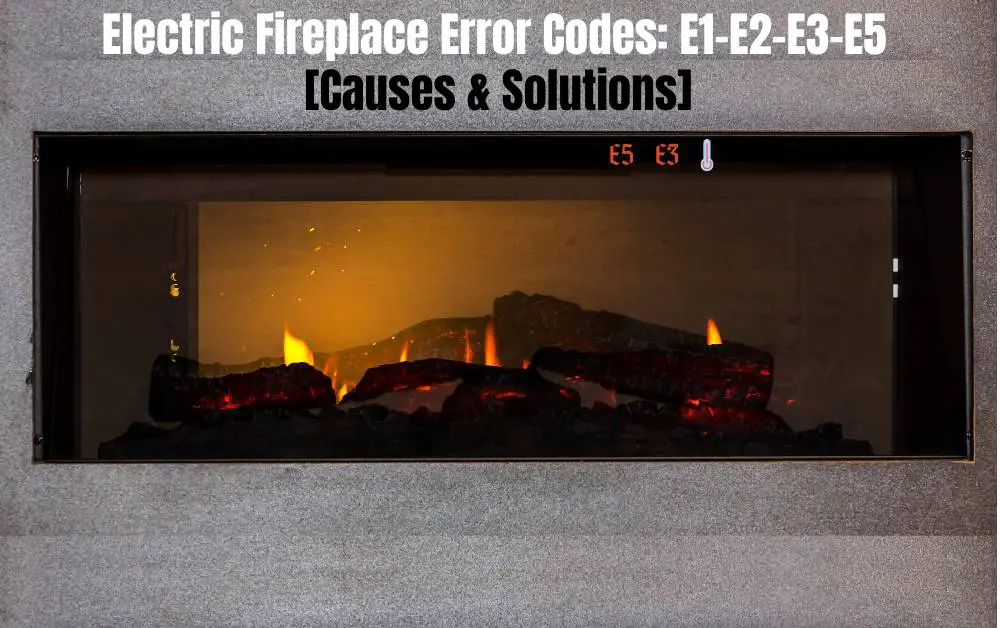Electric fireplaces pose minimal fire risk when used according to guidelines and with due diligence. The key lies in informed usage, regular maintenance, and choosing a quality product that meets safety standards.
In the quest for a warm and cozy ambiance, many homeowners turn to electric fireplaces as a convenient and stylish alternative to traditional wood-burning or gas options. While these electric wonders offer the allure of a crackling fire without the hassle, a common concern lingers: Can electric fireplaces cause fires?
Overview
Most electric fireplace models include an automatic shut-off mechanism that activates when the unit reaches a certain temperature. However, A short circuit in the electrical system of an electric fireplace, or if the inlet and outlet are obstructed by a combination of materials, poses a fire risk.
Can Electric Fireplaces Cause Fires?
Electric fireplaces are generally considered safe when used according to manufacturer instructions. However, like any electrical appliance, they can pose a risk if there are electrical issues, overheating, improper installation, or use of combustible materials nearby.
Here are some factors to consider regarding the safety of electric fireplaces:
Electrical Issues
Like any electrical appliance, electric fireplaces can pose a risk if there are electrical issues. This includes faulty wiring, damaged cords, or using the fireplace with an extension cord that can’t handle the load.
Overheating
If an electric fireplace is misused or malfunctions, it may overheat. Some electric fireplaces have built-in safety features, such as automatic shutoffs when they reach a specific temperature.
It’s essential to follow the manufacturer’s guidelines regarding usage and maintenance to prevent overheating.
Quality and Maintenance
The quality of the electric fireplace can influence its safety. Regular maintenance, such as cleaning the unit and checking for any visible damage, is crucial. Follow the manufacturer’s instructions for cleaning and upkeep.
Combustible Materials
Placing combustible materials too close to the electric fireplace can be a fire hazard. Keep flammable objects like curtains, paper, or furniture at a safe distance.
Installation
Proper installation is essential. If the fireplace is not installed according to the manufacturer’s instructions or if there are any modifications to the unit, it may pose a safety risk.
Use of Extension Cords
Extension cords not rated for the fireplace’s power requirements can be dangerous. It’s recommended to plug electric fireplaces directly into a wall outlet that matches the unit’s voltage.
Child Safety
If you have children, ensure they know the potential dangers of the electric fireplace. Some units come with safety features like cool-touch glass to prevent burns.
To ensure the safe use of an electric fireplace, carefully read and follow the manufacturer’s instructions, perform regular maintenance, and be mindful of potential hazards. If you notice any issues or malfunctions, it’s essential to address them promptly and, if necessary, seek professional assistance.
The Role of User Responsibility
While electric fireplaces are designed with safety in mind, user responsibility is paramount. Avoid overloading electrical outlets, and never use damaged power cords or plugs.
Educate household members on properly using the fireplace, emphasizing the importance of following safety guidelines.
Related Post: What To Put Under Electric Fireplace?
Comparing Electric Fireplaces to Traditional Options
| Feature | Electric Fireplaces | Gas Fireplaces | Traditional Wood-Burning Fireplaces |
|---|---|---|---|
| Installation | Easy and often plug-and-play. | Requires gas line installation. | Typically requires a chimney or vent. |
| Cost of Installation | Generally lower installation cost. | Moderate installation cost, requires gas line. | Higher installation cost with chimney construction. |
| Heat Efficiency | More efficient with options for adjustable heat. | Efficient with adjustable heat. | Heat can escape up the chimney, making them less efficient. |
| Fuel Source | Electricity (plugs into an outlet). | Natural gas or propane. | Wood or other combustible materials. |
| Maintenance | Low maintenance, minimal cleaning. | Regular cleaning and gas line checks. | Requires regular cleaning of chimney and removal of ash. |
| Environmental Impact | Generally considered more environmentally friendly. | Cleaner burning compared to wood. | Burning wood can contribute to air pollution. |
| Safety | Safer; no open flames, often equipped with safety features. | Requires proper ventilation, but generally safer than wood. | Fire risk due to open flames and sparks. Requires caution and supervision. |
| Convenience | Easy to start and control with remote or switch. | Easy ignition with remote control. | Requires manual ignition, tending, and cleanup. |
| Aesthetics | Various design options with simulated flames. | Realistic flame appearance with gas logs. | Authentic and traditional appearance with real flames. |
| Ventilation | Ventless options available. | Requires proper ventilation through a chimney or vent. | Requires proper ventilation through a chimney or vent. |
| Flexibility | Can be placed anywhere with access to an electrical outlet. | Requires a gas line but more flexible in placement. | Limited by the need for a chimney or proper ventilation. |
| Heating Capacity | Typically suitable for smaller spaces. | Can provide substantial heat for larger areas. | Can provide substantial heat for larger areas. |
Affiliate Disclosure: Fireplaceadviser.com is a participant in the Amazon Services LLC Associates Program. We may earn a commission when you click on certain links on this site and purchase.

Hello!! I am Jamal Khan. I often fix my home electric heaters and gas stove problems and research the common issues in the heating units to improve my knowledge and expertise. The aim of establishing fireplaceadviser.com is to share my expertise and knowledge with my audience.












